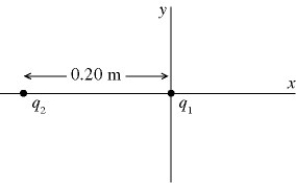Short Answer
Coulomb's law: In the figure, charge  = 3.1 ×
= 3.1 ×  C is placed at the origin and charge
C is placed at the origin and charge  is placed on the x-axis, at x = -0.20 m. Where along the x-axis can a third charge Q = -8.3 µC be placed such that the resultant force on this third charge is zero?
is placed on the x-axis, at x = -0.20 m. Where along the x-axis can a third charge Q = -8.3 µC be placed such that the resultant force on this third charge is zero? 
Correct Answer:

Verified
Correct Answer:
Verified
Q45: Charge in an electric field: A proton
Q46: Coulomb's law: The point charge at the
Q47: Multiple point-charges: A 3.0-μC positive point charge
Q48: Coulomb's law: A positive point charge Q
Q49: Charge: A piece of plastic has a
Q51: Coulomb's law: Two identical small conducting spheres
Q52: Dipoles: An electric dipole is made of
Q53: Charged ring: In the figure, a ring
Q54: Multiple point-charges: Two point charges, Q<sub>1 </sub>=
Q55: Dipoles: An initially-stationary electric dipole of dipole